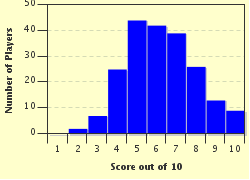Quiz Answer Key and Fun Facts
1. The non use of chemical fertilisers leads to eutrophication of water bodies.
2. Bacteria are eukaryotic cells.
3. A concave mirror is called a converging mirror.
4. Chlorine is the most reactive non-metal of the halogen family.
5. Streamlining reduces friction.
6. Polythene (or polyethylene) is used to make nonstick kitchenware.
7. Yeast reproduce through budding.
8. Sounds of a frequency below 20 Hz are called infrasonics.
9. Mercury is the only planet where an entire rotation about its axis takes a longer time than a complete revolution around the Sun.
10. A network of computers within a campus or an entire building is a LAN.
Source: Author
angikar
This quiz was reviewed by FunTrivia editor
rossian before going online.
Any errors found in FunTrivia content are routinely corrected through our feedback system.

